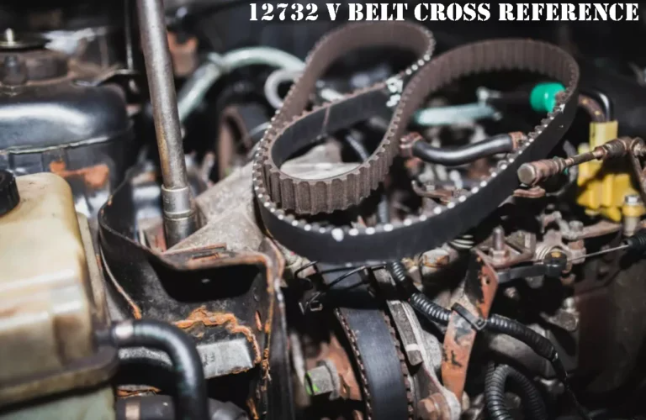Introduction to V Belts
When it comes to machinery and equipment, the efficiency of moving parts is crucial. Among these components, 12732 V Belt Cross Reference play a vital role in transmitting power effectively. If you’re maintaining or repairing any mechanical systems, understanding V belts can save you time and money. One specific type that often surfaces in discussions is the 12732 V belt.
But what exactly makes this belt stand out? And why should cross-referencing be on your radar? Let’s dive deeper into the world of 12732 V Belt Cross Reference and uncover what you really need to know about them for optimal performance.
What is a 12732 V Belt?
The 12732 V Belt Cross Reference is a specific type of belt used in various mechanical applications. It plays a vital role in transferring power between rotating shafts.
Typically made from durable materials, this belt features a trapezoidal cross-section. Its design allows for efficient grip and minimal slippage on pulleys.
You’ll find the 12732 V Belt Cross Reference commonly in industrial machinery, lawn equipment, and automotive engines. Each application requires precision to maintain optimal performance.
Knowing its specifications is essential for maintenance or replacement tasks. The number itself indicates dimensions that are critical for compatibility with different systems.
When searching for replacements, understanding these details can save time and resources while ensuring smooth operation of your machinery.
The Importance of Cross Referencing V Belts
Cross-referencing 12732 V Belt Cross Reference is crucial for maintaining efficiency in machinery. Using the correct belt ensures that equipment operates smoothly and minimizes wear and tear.
Different manufacturers may have varying part numbers for similar belts. This can lead to confusion when it comes time to replace them. Cross-referencing helps you find equivalent options, guaranteeing compatibility.
Failing to cross-reference could result in purchasing the wrong belt, causing delays or additional repair costs. It impacts not just performance but also safety in certain applications.
Staying updated on cross-reference tools saves time during maintenance tasks. You can quickly identify suitable replacements without extensive research or trial-and-error methods.
Understanding how to navigate these references empowers users, ensuring they select optimal solutions tailored to their specific needs. It’s about enhancing productivity while safeguarding your equipment’s longevity.
How to Use 12732 V Belt Cross Reference Tools
Using a 12732 V Belt Cross Reference cross reference tool is straightforward. Begin by identifying the existing belt’s model number or specifications. This information is crucial for accurate matching.
Next, access an online database or catalog that specializes in 12732 V Belt Cross Reference. Many manufacturers provide these resources on their websites. Input your model number into the search bar and hit enter.
The results will display various compatible options. Take note of different brands and sizes available, as well as any alternative part numbers listed.
It’s wise to double-check measurements like length and width to ensure compatibility with your machinery. Keep an eye out for additional details such as material type, which can affect performance.
If you’re unsure about any aspect, reaching out to customer support can clarify uncertainties, helping you make informed choices with confidence.
Common Misconceptions about V Belt Cross Referencing
Many people believe that all V belts are interchangeable, but that’s not the case. Each belt is designed for specific applications and loads. Using the wrong one can lead to premature wear or even mechanical failure.
Another common misconception is that cross referencing only applies to brand names. While it’s true that different brands may produce similar belts, size and specifications matter most. Always check dimensions before making a switch.
Some think cross-referencing is complicated. However, with modern tools and online databases, finding compatible options has never been easier.
People also assume they need an exact match when replacing a V belt. In reality, many alternatives work effectively if they meet the necessary specifications.
There’s a belief that price equates to quality in V belts. While cost can be an indicator of durability, it’s essential to focus on performance ratings and compatibility first.
Tips for Choosing the Right Replacement V Belt
Choosing the right replacement V belt is crucial for optimal performance. Start by checking the specifications of your current belt. Look for dimensions, shape, and material type.
Next, consider the application. Different machines may require belts designed for specific loads or environmental conditions. Heavy-duty applications need stronger belts to withstand wear.
Inspecting the pulleys can also help with selection. Ensure they are in good condition and compatible with your chosen belt size and style.
Don’t overlook brand reputation either. Some manufacturers are known for durability while others might offer better pricing but lower quality.
Consult online resources or local suppliers who have experience in V belts. They can provide valuable advice tailored to your needs, ensuring you make an informed decision when selecting a replacement belt that fits seamlessly into your machinery setup.
Conclusion
Selecting the right V belt is crucial for maintaining the efficiency of your machinery. The 12732 V belt cross reference can be a helpful tool in this process, ensuring you find compatible replacements with ease. By understanding what a 12732 V belt is and mastering the art of cross-referencing, you’ll enhance your knowledge and confidence when it comes to choosing parts.
Always remember to utilize reliable resources for cross-referencing and do not hesitate to consult experts if you’re uncertain about any aspect. Armed with these insights, you’ll ensure that your equipment runs smoothly without unnecessary downtime caused by mismatched components or poor-quality belts. Choosing wisely now will save time and costs later, keeping everything in top shape for optimal performance.


